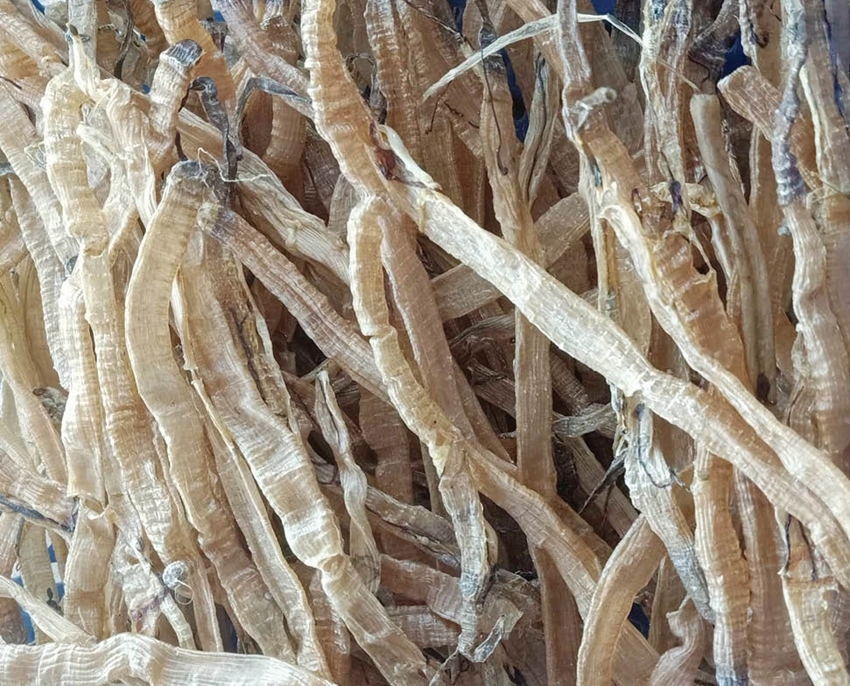 |
| The area next to the lagoon in Quang Cong (Quang Dien) is where many peanut worms live. |
Since added to the list of endangered rare water creatures which need protecting from extinction, peanut worms have become a source of profit for people living next to the sea and the lagoon.
To people in Phu Thuan, Phu Hai, Phu Vang, these “earth dragons” have been so far considered “ginseng of the lagoon.” They are protected and exploited effectively like fish and shrimps in Tam Giang Lagoon, becoming livelihoods for generations of people there.
Thanks to good protection, “earth dragons” have recently been prolific in alluvial lands and people’s fish and shrimp pools. One kilogram of dried peanut worms costs about VND2,000,000.
We had a talk with Le Nhat Mong, a fisherman living in the lagoon area in Phu Thuan, who has taken peanut worm hunting as his career for many years now in his free time while waiting for the water to subside from the alluvial land. Though he is a fisherman, he chooses to become a peanut worm hunter. He catches peanut worms, processes them, then sells them to merchants or restaurants in the area.
 |
| Dried peanut worms |
According to Mong, previously many people had worked as peanut worm hunters. When hunting for them was prohibited, the career gradually died down. In recent years, peanut worms have become prolific again in alluvial grounds and fish and shrimp pools, bringing lots of profit for local people.
According to Mong as well, the hunting season for peanut worms is from March to September when the tide subsides, revealing alluvial grounds along lagoons and estuaries. One kilogram of peanut worms is sold on site to merchants at the price of VND150,000. On average, one hunter can catch over 10 kilograms of peanut worms a day.
Hunters use a tool which they themselves make out of iron. By observing holes on the mud, they can guess where their homes are. They then dig them up quickly. If not, peanut worms may run away.
At noon, when the tide subsides, there appear Con Son, Phu Thuan vast alluvial lands. Besides alluvial lands, there are fish and shrimp pools too. After fish and shrimps are harvested, peanut worm hunters bid the pool to catch peanut worms. For every kilogram of peanut worms, the pool owner earns VND50,000-60,000.
“On average, a pool owner can earn some million Vietnamese dongs. Some owners earn up to VND100,000,000. Peanut worms live on food remainder in fish and shrimp pools, helping protect the environment. After all the fish, shrimps and peanut worms are harvested, the owner processes the pool with lime and chemicals in preparation for a new harvest.
Mong obtains about 8-10 kilograms of peanut worms a day in alluvial lands in Con Son. He either sells them to merchants or dry them, then sell them to restaurants in the province. He has a processing facility at home.
"Peanut worms are called “ginseng from under the ground” because they are medicinal and high in nutrition. They are my livelihood. But I think we should find ways to protect them. I never catch them in their breeding season. Only in that way do we have a sustainable career,” said Mong.
Many years ago, some households from elsewhere came to catch, buy and process peanut worms. In order to protect the soil and biodiversity, the commune decided to ban the exploitation. Aware of the issue, local people agreed not to overexploit them.
|
|
| Peanut worms are well known as unique food. In ancient times, they were a specialty offered to the king. Peanut worms belong to the Sipuncula family, and their scientific name is Sipunculus nudus. They are of various colors and about 5-10cm long; some are up to 15-40cm. Besides their nutritious value, according to many modern medical studies, they support the treatment of a number of respiratory and osteoarthritis diseases. |